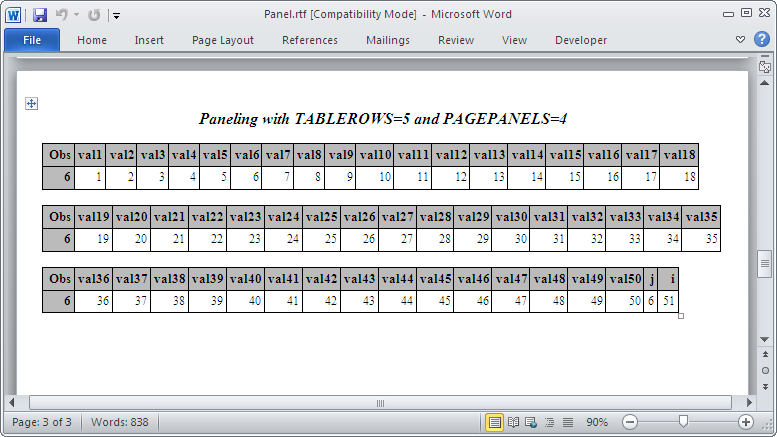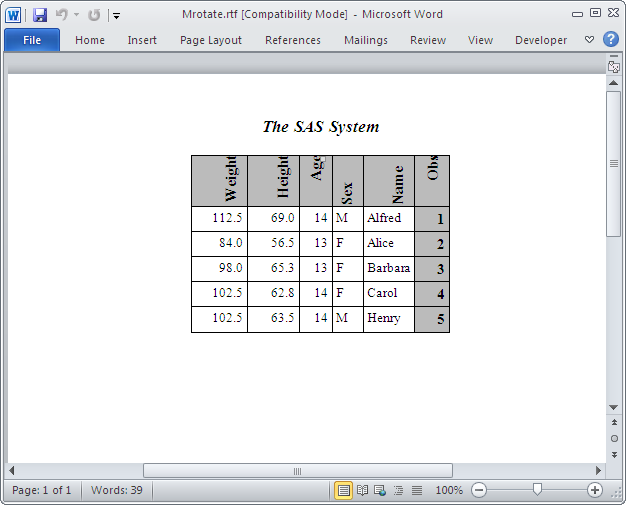Ods output rtf options
This ODS destination creates output that can be read by various word processing packages including Microsoft Word and WordPerfect. As in the HTML destination, in RTF you can use PROC TEMPLATE to modify the colors, fonts, margins, and so forth.
The PROC TEMPLATE documentation lists the available style elements and attributes. Some of the style elements and attributes are HTML-specific, but most can be used with the RTF destination as well. Unlike the HTML destination, the RTF destination creates only a body file. The RTF specification is a method of encoding formatted text and graphics for transfer between applications and operating environments.
The RTF file uses ANSI, PC-8, MAC, and IBM PC character sets. The text is formatted by control words, control symbols, and groups.
A control word is a specially formatted command that RTF uses to mark printer control codes and document management information. Limited ability to add control words and symbols is supported in 8. A group can specify how to format a portion of text or, more generally, how to format items such as fonts, styles, headers and footers, and even the document, section, paragraph, and character properties.
For more details, see the specifications of an RTF file. RTF Titles and Footnotes Because, in ODS, titles and footnotes are written to the header and footer sections of an RTF file, the text might appear onscreen to have a faded gray color.

This behavior exists even if you apply a style that modifies the color. However, the color is correct when viewed in the Print Preview window or when printed.
These options can be specified separately or together. Styles can also be applied globally to the titles and footnotes by creating a style template with PROC TEMPLATE. For example, you can insert subscripts and superscripts or specify a style for each title or footnote. Also, destination-specific information can be added to the title and footnotes by inserting raw text directly.
For example, if you are generating both HTML and RTF from a procedure, the RTF-specific information is ignored by the HTML destination. User's Guide , which is available in the Base SAS documentation.
SAS Programming on Report Generating: Part 2: ODS: Creating Excel Output with multiple work sheetsThough the following examples use the TITLE statement, the same techniques can be used for footnotes and cell values. View an RTF file that contains output for the following examples. Adding Superscripts and Subscripts Here is an example that adds a superscript and a subscript. Beginning with Release 8.
Sprites mods - Use a cheap digital photoframe as a second display for your PC - Introduction
Destinations other than RTF ignore the raw text. The first example passes tab characters.
Set the attribute within the style element SystemTitle for the titles and Systemfooter for the footnotes. Below is a list of some commonly used control words.
See the RTF specification for a complete list.
The control words can be combined within the TITLE and FOOTNOTE statements as in the example below, which left-justifies, underlines, and splits the title over two lines. However, if you apply options on a TITLE, FOOTNOTE, or GOPTION statement, they override the PROC TEMPLATE styles. If multiple styles are defined, here is the order of precedence, the higher items overriding the lower ones:.
Below is a style template created with PROC TEMPLATE that changes the foreground color to red and left-justifies the titles. The RTF destination uses the style template STYLES. RTF inherits its fonts and four basic colors from the style template STYLES. See the Colors Concepts for an explanation of the shorthand way that colors are assigned, as well as instructions for modifying colors. If multiple styles are defined, here is the order of precedence, the higher items overriding the lower ones: RTF Fonts The fonts for the style template STYLES.
Base SAS: ODS RTF | SAS Support
RTF are inherited from the style template STYLES. PRINTER, within the style element Fonts. In a shorthand method like that for colors , the string 'TitleFont' defines the fonts associated with the titles and footnotes.
The string "docFont" associates fonts responsible for the cell values. The string "headingFont" associates the fonts responsible for the column headings. When specifying a font size for the RTF destination, be sure to include the unit of measure PT, for points.
This allows the size that you specify to carry over in Word. Most word processors use PT as the default unit of measure.

Here is the Fonts style element from the style template STYLES. As mentioned earlier, you can take advantage of inheritance from the style template STYLES. RTF and build on it.
The examples in this document are specific to the RTF destination. The concepts remain above, but the FAQs have been moved. All PROC TEMPLATE FAQ have been added to the support.
See the ODS RTF section. Style RTF Control Word Example Code Italicize.